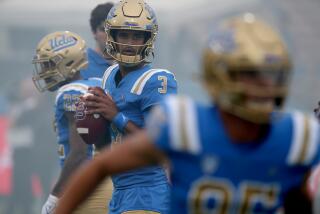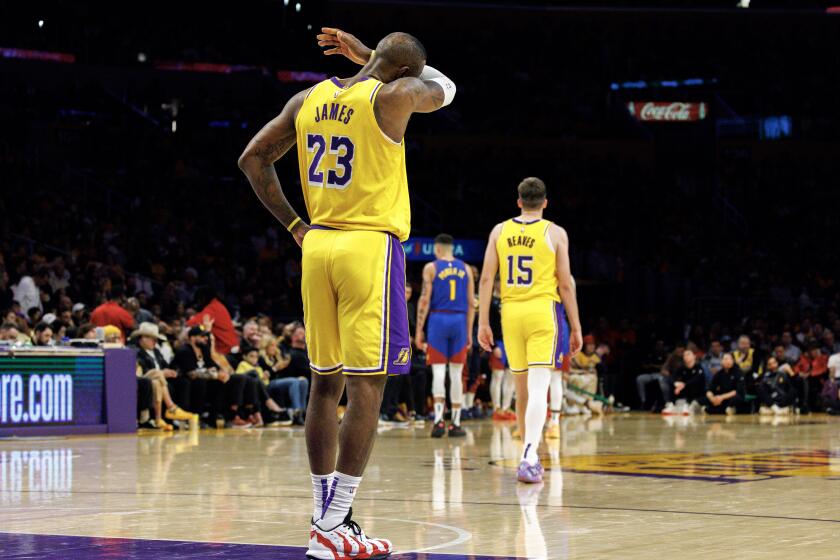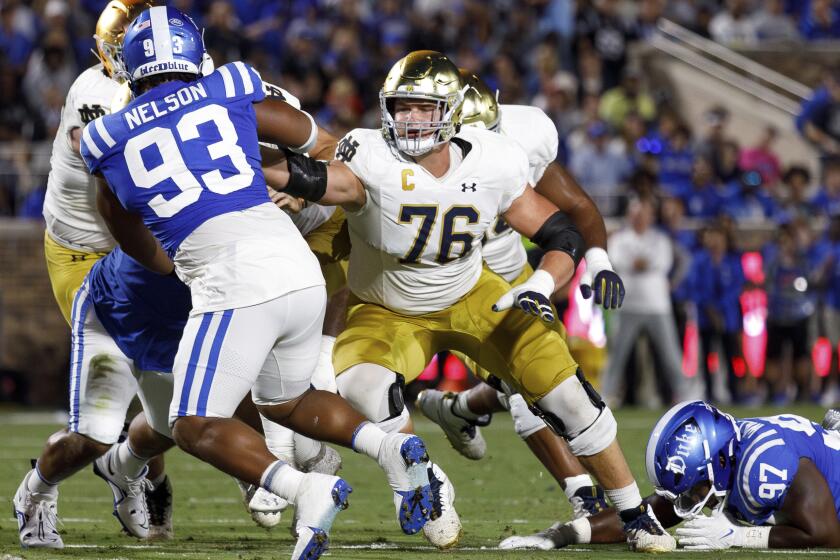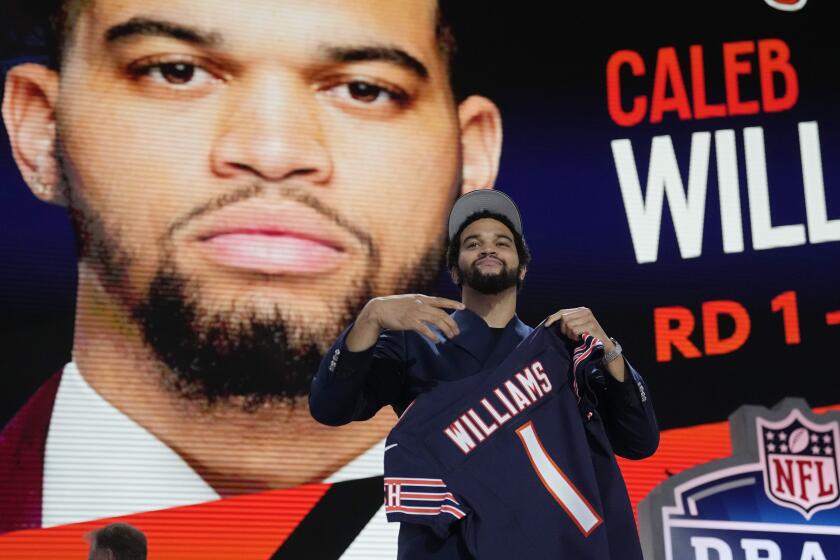Column: College football mailbag: How ‘true’ a freshman is BYU quarterback Tanner Mangum?
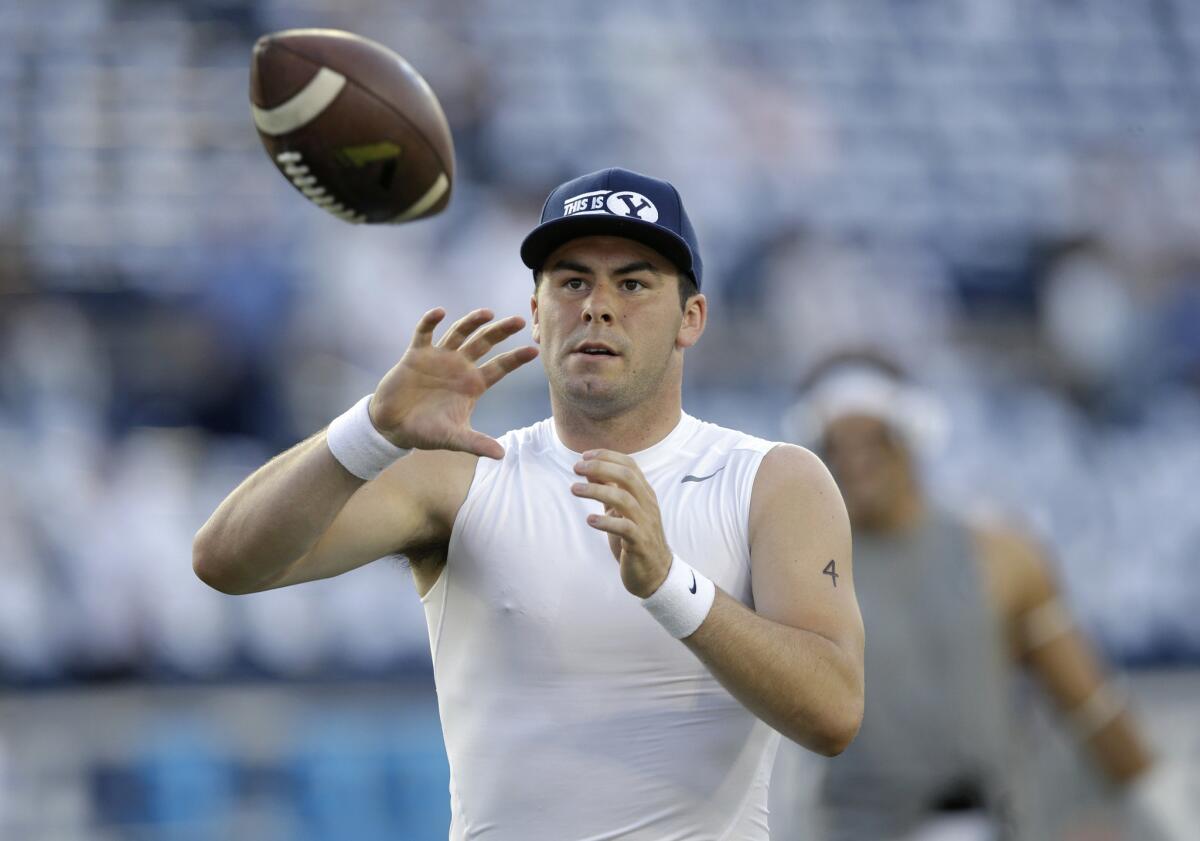
BYU quarterback Tanner Mangum catches a pass during practice before a game against Boise State on Sept. 12.
Each week during the college football season, national analyst Chris Dufresne will burn a timeout to answer questions and exchange opinions. You can email him at chris.dufresne@latimes.com and reach him at @DufresneLATimes on Twitter.
Unbuckling the mailbag:
It’s too bad lazy sportswriters reach for the worn-out BYU age “advantage.” Sorry, but there are no correlating stats.
Joseph McGregor
I’ve been getting hammered all week for questioning whether Brigham Young quarterback Tanner Mangum should be referred to as a “true” freshman.
This conversation turned into a Twitter fight over whether BYU had a competitive advantage because its players went on service missions before their NCAA athletic eligibility clocks started.
Technically, Mangum is a “true,” or first-year, freshman. It’s fitting, though, that this week he is facing Josh Rosen, UCLA’s outstanding “true” freshman quarterback.
Mangum is 22 years old. Rosen is 18.
Mangum, in 2011, shared co-MVP honors at an Elite 11 summer camp — with Jameis Winston.
After high school, Mangum took a gray shirt year at BYU, during which he was allowed to practice and learn the Cougars’ offensive system. He then embarked on a nearly two-year Mormon mission to Chile.
Last year, Rosen was playing football for Bellflower St. John Bosco High.
Mangum has been terrific in relief of the injured Taysom Hill, leading BYU into the top 25 with consecutive last-minute touchdown throws against Nebraska and Boise State.
I suggested a different word to describe Mangum. “False” freshman was harsh, but I thought “special” freshman was a more apt description.
And then all Hades broke loose...
::
Go on a two-year LDS mission where you can only exercise 30 minutes a day and let me know how in shape you are.
Dan Findley @Coachfindley
I was in no way diminishing Mangum’s sacrifice, service or devotion. I understand he was not able to practice football or regularly exercise.
Mangum returned from his 22-month mission last June and I’m sure he was nowhere close to being in football shape.
It could be argued, though, that the maturity he gained might give him an advantage over other freshmen just coming out of high school.
In fact, it was Mangum who told ESPN.com the perspective he gained on his mission helped him deal with the pressure of entering the season-opening game, at Nebraska, after Hill was injured.
::
Sorry Chris, this is not your area of expertise. Unless you’ve been on a two-year mission? I have, and it’s no advantage.
Tyler Slade @truebluebyu1
I am no expert on that. I know many opposing coaches do believe that BYU’s system does produce a maturity advantage.
Colleague Tom Kensler, recently retired from the Denver Post, passed along that former Colorado State Coach Earle Bruce once said of BYU: “They’re big. They’re strong. And they’re old!”
::
Nobody is stopping UCLA from sending their players to foreign countries without footballs or weight rooms for two years.
Andrew Bean @ahb4050
According to ESPN.com, Mangum did pack a football on his mission and occasionally played catch with BYU receiver Moroni Laulu-Pututau, who was part of the same missionary group.
::
If Jim Mora sees an advantage because of missions, he should enlist his players in the Army/Peace Corps.
Bruce Nilsson
Taking his UCLA players to San Bernardino, and then screaming at them for two weeks, is pretty close to boot camp.
::
Did people freak out the same way over Chris Weinke in the ‘90s? I’m honestly not sure. They were both away from football.
Greg Welch @ArtDirectorBYU
That’s an interesting comparison. Chris Weinke is the only college player I’ve ever called “sir.” While his Florida State teammates were playing video games, Weinke was playing the stock market.
His favorite play was “Z-out 401k.”
Time away from football certainly did not diminish Weinke’s talent.
He spent six years playing minor-league baseball before taking up football again at Florida State.
At 27, he led the Seminoles to the national title in 1999 and the next year, at 28, became the oldest winner of the Heisman Trophy.
Some thought his age and maturity gave him an advantage over younger college players.
::
We should all probably wait for @DufresneLATimes article about altitude being an advantage in football too. Always entertaining.
Daniel Nelson
Hmm... Let me consider that. If a two-year mission provides a distinct advantage for BYU players, what about a player sent to a high-elevation location such as La Paz, Bolivia?
La Paz is at 11,913 feet above sea level; Provo is 4,549 feet. That’s an altitude difference of 7,364 feet.
Imagine the lung capacity a BYU player, in two years, could develop?
Of course, some experts think altitude is overrated as it relates to athletic competition. Nevada Las Vegas, basketball player Moses Scurry, before the 1990 NCAA basketball Final Four in Denver, worried altitude could hurt the Runnin’ Rebels’ frenetic playing style.
“Don’t worry about it,” UNLV Coach Jerry Tarkanian told him. “We’re playing indoors.”
::
Safe to say I NEVER thought I’d see MSU No. 2 in Rankman’s top 25! ... Anyway, thanks for the Spartan love!
Joel Schechter
I think you should reward schools that play tough, home-and-home nonconference schedules. Last year, Michigan State took a hit by losing at Oregon and so, conversely, it should get a nice bump for defeating the Ducks last weekend.
I don’t mind teams playing neutral site games, but it’s not the same as going into a visiting stadium. Alabama plays a quality nonconference schedule but hasn’t visited an opposing stadium since Penn State in 2011.
::
You can’t mention often enough the Southeastern Conference playing eight and the Pac-12 playing nine as far as I’m concerned.
Mark Carpenter
I’ll mention it again. It’s wrong, it’s wrong, it’s wrong. All Power 5 conferences should play the same number of league games.
::
Shelby Foote, the great Civil War historian talking about Robert E. Lee: “He was superior on both the offensive and the defensive. He took long chances because he had to. The only way to win was with long chances and it made him brilliant.”
In an odd way, a football game is like war. Sometimes you have to take chances; think out of the box.
Remember when Chris Petersen at Boise State was daring and exciting and successful? Now, at the Udub he is so predictable.
Paul Hovsepian
Football is not war, but there are certainly strategic parallels and I greatly appreciate your thoughts regarding Chris Petersen.
When you are undermanned, as Petersen was at Boise State, you do have to take more chances. Boise State stunned Oklahoma in the 2007 Fiesta Bowl with trickery and deception capped by a hook-and-lateral play followed by the game-winning Statue of Liberty.
Petersen couldn’t play personnel-superior Oklahoma straight up any more than the Continental Army could wage conventional war against the British.
The war metaphor lives, and breathes, in football.
True story: I was covering the Raiders at the start of the first Gulf War in January 1991.
We were in the press room at the team’s facility in El Segundo when the news broke. I wandered out to practice and saw Raiders owner Al Davis observing his team, as usual, from the corner of the field.
This was before cellphones and the Internet were widely used, so I figured Al was cut off from this breaking information. I approached Mr. Davis to tell him the war had started.
He looked at me, paused a few seconds, and said: “We’ve just got to bomb the [bleep] out of them.”
That was Davis’ football philosophy: Go for the jugular with deep aerial strikes. He called it the vertical game. He fancied strong-armed quarterbacks such as Daryle Lamonica, known as “The Mad Bomber.”
We beat Iraq with vertical strikes. But the Raiders, with howitzer-armed quarterback Jay Schroeder, threw mostly duds in the AFC title game, at Buffalo, on Jan. 20, 1991.
The Bills won, 51-3.
More to Read
Get our high school sports newsletter
Prep Rally is devoted to the SoCal high school sports experience, bringing you scores, stories and a behind-the-scenes look at what makes prep sports so popular.
You may occasionally receive promotional content from the Los Angeles Times.


